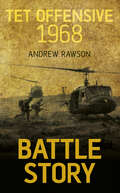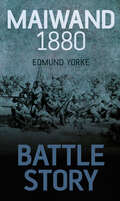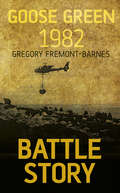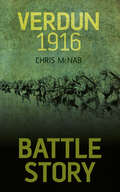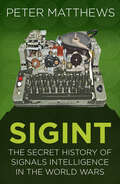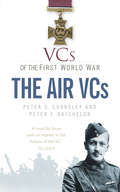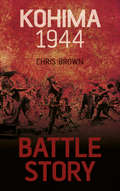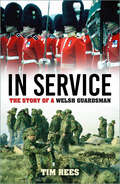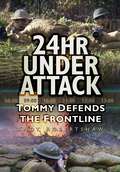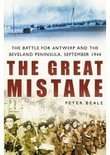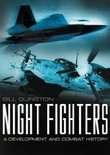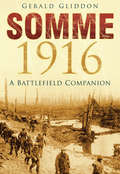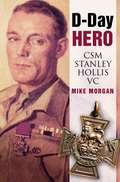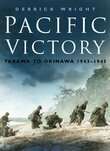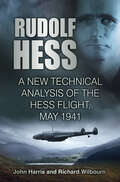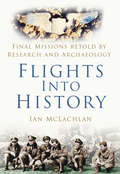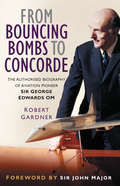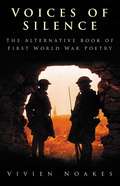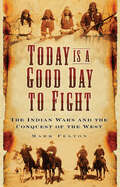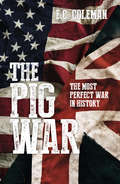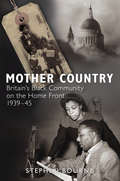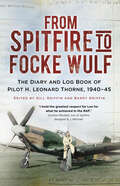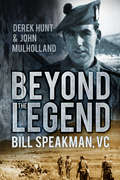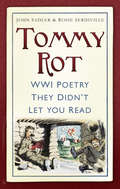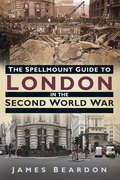- Table View
- List View
Battle Story: Tet Offensive 1968 (Battle Story Ser.)
by Andrew RawsonBy the end of January 1968 the American people thought their armed forces were winning in South Vietnam after three years of escalating confl ict. Then the North Vietnamese Army and Viet Cong struck back, hitting military and political targets across the country. While the NVA and Viet Cong suffered a military defeat, they dealt a huge blow to US support for the war. If you want to understand what happened and why - read Battle Story. Detailed profiles examine the background of the opposing commanders, as well as the contrasting tactics and equipment of their fighting forces. Contemporary accounts reveal the true story of this pivotal battle and its consequences for the Vietnam War. Specially commissioned maps analyse the key developments during the battle. Excellent photographs place the reader at the centre of the fighting. Orders of battle show the composition of the opposing forces’ armies.
Battle Story: Maiwand 1880 (Battle Story Ser.)
by Edmund YorkeThe Battle of Maiwand was a key clash in the Second Anglo-Afghan War and one of the most serious defeats of the British Army during the ‘Great Game’. British and Indian troops, in an attempt to intercept Afghan forces at the Maiwand Pass, disastrously underestimated the strength of the enemy and were heavily defeated. If you want to understand what happened and why – read Battle Story. Detailed profiles explore the personalities of the British and Afghan leaders, Brigadier General George Burrows and Ayub Khan. Diary extracts and quotes detail the intense fighting and the causes of the British defeat. Maps examine the movements of the British and Afghan forces as they clashed at the Maiwand Pass Contemporary images place the reader at the forefront of the unfolding action. Orders of battle show the composition of the opposing forces’ armies. Packed with fact boxes, this short introduction is the perfect way to explore this crucial battle.
Battle Story: Goose Green 1982 (Battle Story Ser. #4)
by Gregory Fremont-BarnesThe Battle of Goose Green was the first and longest land conflict of the Falklands War, which was fought between British and Argentine forces in 1982. The British forces, attacking over featureless, wind-swept and boggy ground, were heavily outnumbered and lacked fire support, but brilliantly defeated the Argentine garrison in a fourteen-hour struggle. If you want to understand what happened and why – read Battle Story. Detailed profiles examine the personalities of the British and Argentine commanders, including that of Victoria Cross winner Lt Col ‘H’ Jones. First-hand accounts offer an insight into this remarkable fourteen-hour struggle against the odds. Detailed maps explore the area of Darwin Hill and Goose Green, and the advance of the British forces. Photographs place you at the centre of this pivotal battle. Orders of battle show the composition of the opposing forces’ armies. Packed with fact boxes, this short introduction is the perfect way to explore this crucial battle.
Battle Story: Verdun 1916 (Battle Story Ser.)
by Chris McNabThe Battle of Verdun was one of the bloodiest engagements of the First World War, resulting in 698,000 deaths, 70,000 for each of the 10 months of battle. The French Army in the area were decimated and it is often most tragically remembered as the battle in which the French were ‘bled white’. A potent symbol of French resistance, the fortress town of Verdun was one that the French Army was loath to relinquish easily. It was partly for this reason that the German commander chose to launch a major offensive here, where he could dent French national pride and military morale. His attack commenced on 21 February, using shock troops and flamethrowers to clear the French trenches. Starting with the capture of Fort Douamont, by June 1916 the Germans were pressing on the city itself, exhausting their reserves. The French continued to fight valiantly, despite heavy losses and eventually rolled back German forces from the city. In the end it was a battle that saw much loss of life for little gain on either side.
SIGINT: The Secret History of Signals Intelligence in the World Wars
by Peter MatthewsSIGNALS INTELLIGENCE, or SIGINT, is the interception and evaluation of coded enemy messages. From Enigma to Ultra, Purple to Lorenz, Room 40 to Bletchley, SIGINT has been instrumental in both victory and defeat during the First and Second World War. In the First World War, a vast network of signals rapidly expanded across the globe, spawning a new breed of spies and intelligence operatives to code, de-code and analyse thousands of messages. As a result, signallers and cryptographers in the Admiralty’s famous Room 40 paved the way for the code breakers of Bletchley Park in the Second World War. In the ensuing war years the world battled against a web of signals intelligence that gave birth to Enigma and Ultra, and saw agents from Britain, France, Germany, Russia, America and Japan race to outwit each other through infinitely complex codes. For the first time, Peter Matthews reveals the secret history of global signals intelligence during the world wars through original interviews with German interceptors, British code breakers, and US and Russian cryptographers. "SIGINT is a fascinating account of what Allied investigators learned postwar about the Nazi equivalent of Bletchley Park. Turns out, 60,000 crptographers, analysts and linguists achieved considerable success in solving intercepted traffic, and even broke the Swiss Enigma! Based on recently declassifed NSA document, this is a great contribution to the literature." THE ST ERMIN'S HOTEL INTELLIGENCE BOOK OF THE YEAR AWARD 2014.
VCs of the First World War: Air Vcs (Vcs Of The First World War Ser.)
by Peter G. Cooksley Peter F. BatchelorOf more than 600 Victoria Crosses awarded to British and Empire servicemen during the First World War, nineteen were awarded to airmen of the newly formed Royal Flying Corps and Royal Naval Air Service. Of these, four were posthumous awards and all but one of the total were to officers. Some of these valorous airmen were from humble backgrounds and with limited education, others were collegiate men from wealthy families, but in the words of one senior officer they all had in common ‘the guts of a lion’.
Battle Story: Kohima 1944 (Battle Story Ser.)
by Dr Chris BrownKohima was the turning point in the Japanese invasion of India, witnessing the end of their attempt to overthrow the British Raj. It was a bitter battle fought in three stages, spanning three months and ending with the siege of Imphal. Losses on both sides were heavy, with the Japanese suffering their greatest land defeat thus far in the war. Against the odds and an enemy who nearly refused to give in, the British Army resisted the Japanese and their victory paved the way for the reconquest of Burma. Battle Story: Kohima explores the historical context of this critical point in the war in Asia, the personalities of the opposing armies and offers a blow-by-blow account of the battle.
In Sights: The Story of a Welsh Guardsman
by Tim ReesIn Sights is one man's journey from boyhood to manhood, ultimately finding himself in the theatre of war. It is a journey littered with colourful anecdotes that offer insight into male bonding. Few paths have included such diverse experience. From military training in the Guards Depot to Trooping the Colour, from academic failure to intelligence work in Northern Ireland; from helping Rudolf Hess out of an ambulance to being tasked with taking the Queen's portrait. He even trod on Lady Diana's toes! Tim Rees colours every experience with profound and often idiosyncratic observations that offer the reader a taste of the sometimes humorous, often arduous and, on too many occasions, brutal reality. Close friends were killed or injured aboard RFA Sir Galahad off Fitzroy in the Falklands. Historically, men have gone to war en masse. Today, only relatively few men experience war. Was war a traumatic experience? Yes. Disturbing? Yes. Has experience of war and military service had a positive effect on Tim's life? Yes. Tim says, 'The positive effect is the bond of common experience I share with men with whom I served in the army. the bond is very strong and very different from civilian friendships. The bond military men share is unique. And I would argue that these bonds have historically been very important to the fabric of society and now they are being lost.'
24hr Under Attack: Tommy Defends the Frontline
by Andrew RobertshawTen million military personnel died during the Great War. Many millions of them experienced horrendous enemy attacks on entrenched positions that stretched across France and Belgium, as well as further afield. This groundbreaking book relives twenty-four hours of an actual Platoon under attack, using a battalion war diary to follow the assault hour by hour. A team of historians and archaeologists reconstructs the fighting, revealing how the British Tommy defended his hard-won positions against heavy fire and enemy attack. Robertshaw presents the Great War in colour, as it was experienced, using stunning images to bring the the full force of these frightening assaults to life. This truly is First World War history at its finest.
The Great Mistake: The Battle for Antwerp and the Beveland Peninsula, September 1944
by Peter BealeOn 4 September 1944, the British 11th Armoured Division entered Antwerp, capturing the docks intact. Basing his account on official war diaries, unit histories and personal recollections, Peter Beale examines the background, considers the actions taken and forgone between 4 and 26 September and reviews their effects on subsequent operations.
Night Fighters: A Development and Combat History
by Bill GunstonFrom its beginnings during World War I, the role of the dedicated night fighter aircraft and its pilots in the 21st century has evolved greatly. This work reflects the massive changes in technology and in tactics. It also covers the problems of tracking aerial targets by radar.
Somme 1916: A Battlefield Companion
by Gerald GliddonGerald Gliddon's classic survery of the Somme battlefield in 1916, first published in 1987 to great acclaim, has been greatly expanded and updated to include the latest research and analysis. Supported by a wide selection of archive photographs and drawing on the testimony of those who took part, this new edition covers both the famous battle sites, such as High Wood and Mametz Wood and lesser known villages on the outlying flanks. It includes a day-by-day account of the British build-up on the Somme and the ensuing struggle, British and German orders of battle and a full history of the cemeteries and memorials, both 'lost' and current, that sprang up in the years following the First World War. The author also provides thumbnail biographies of all the senior officers to fall, as well as the winners of the Victoria Cross and those who were 'shot at dawn'. In addition, Somme 'personalities' such as George Butterworth are covered in far greater detail than before.
D-Day Hero: M Stanley Hollis VC
by Mike MorganStanley Hollis won the Victoria Cross when, on 6th June 1944, he single-handedly stormed a German pillbox before going on to save the lives of two comrades. Drawing on Hollis's personal diaries and letters, the author describes the real man behind the heroic image.
Pacific Victory: Tarawa to Okinawa 1943-1945
by Derrick WrightThe American ‘island-hopping’ campaign in the Pacific was a crucial factor in the eventual defeat of Japan in 1945. In November 1943, Tarawa tested the doctrine of seaborne assault to the limit in a 76-hour battle. Peleliu in September 1944 was the ‘unknown battle’, where a combination of poor planning, dubious leadership and a major change in Japanese defensive strategy turned what was expected to be a three-day engagement into one of the most savage battles of the war. Iwo Jima in February 1945 was a titanic struggle that eclipsed all these battles, as three Marine divisions fought in appalling conditions against an enemy for whom surrender was not an option. Okinawa was a foretaste of what could be expected in the proposed assault on the Japanese mainland. These battles were all characterised by savage fighting and heavy casualties on both sides. Japanese garrisons often fought to the death and kamikaze air attacks posed grave threats to the supporting US forces. Employing archive colour and black and white photographs, maps and first-hand accounts, the author relates these pivotal battles to the wider struggle against the Japanese in the Pacific.
Rudolf Hess: A New Technical Analysis of the Hess Flight, May 1941
by John Harris Richard WilbournOn 10 May 1941, on a whim, Hitler's deranged deputy Rudolf Hess flew a Messerschmitt Bf 110 to Scotland in a bizarre effort to make peace with Britain; Goering sent fighters to stop him but he was long gone. Imprisoned and tried at Nuremberg, he would die by his own hand in 1987, aged 93. That's the accepted explanation. Ever since, conspiracy theories have swirled around the famous mission. How strong were Hess's connections with the British establishment, including royalty? Was the death of the king's brother, the Duke of Kent, associated with the Hess overture for peace? In the many books written about Hess, one obvious line of enquiry has been overlooked, until now: an analysis of the flight itself - the flight plan, equipment, data sheets, navigation system. Through their long investigation, authors John Harris and Richard Wilbourn have come to a startling conclusion: whilst the flight itself has been well recorded, the target destination has remained hidden. The implications are far reaching and lend credence to the theory that the British establishment has hidden the truth of the full extent of British/Nazi communications, in part to spare the reputations of senior members of the Royal Family. Using original photography, documentation and diagrams, Rudolf Hess sheds new light on one of the most intriguing stories of the Second World War.
Flights Into History: Final Missions Retold by Research and Archaeology (History Press Ser.)
by Ian McLachlanIn this compelling sequel to Final Flights, aviation archaeologist Ian McLachlan has reconstructed the dramatic last flights of Second World War airmen, including the first Fortress to fall in combat from the USAAF's 447th Bomber Group; the final flight of an intruder Mosquito pursuing a German night fighter; the courage of a Lancaster pilot responsible for six lives aboard a burning aircraft; the story of a Spitfire's last flight and its heroic Belgian pilot. Exciting stories are also recounted of those whose misdirected courage saw them serve under the swastika. In reconstructing long-forgotten wartime events, often from buried wreckage, eyewitness accounts and contemporary documentation, aviation archaeologists can bring recognition to the individual flyers involved and shed new light on the air war over Britain and Europe during the Second World War. Even the discovery of small fragments can be significant. They provide evidence or prompt new research, revealing stories that offer a uniquely human dimension and reveal the hopes, fears, aspirations and pleasures of the aircrew involved. Ian McLachlan and other aviation archaeologists have now done them justice.
From Bouncing Bombs to Concorde: The Authorised Biography of Aviation Pioneer Sir George Edwards OM
by Robert GardnerGeorge Edwards' name is synonymous with the Vickers Viscount, the world's first turboprop airliner; the controversial TSR2 project and the legendary Anglo-French Concorde. During the Second World War, it was Edwards who made the Dam Busters' bouncing bombs bounce.
Voices of Silence: The Alternative Book of First World War Poetry
by Vivien NoakesThe poetry of the First World War has determined our perception of the war itself. This volume features poetry drawn from old newspapers and journals, trench and hospital magazines, individual volumes of verse, gift books, postcards, and a manuscript magazine put together by conscientious objectors.
Today is a Good Day to Fight: The Indian Wars and the Conquest of the West
by Dr Mark FeltonBlood, guts, dust and hatred: the real history of the American West. Today is a Good Day to Fight covers the period from the initial penetration of the region by settlers and prospectors in the 1840s until the end of the Indian Wars in the 1890s. It explains the history of white-Indian conflict from the military point of view, showing how the United States used its army to wage terrible wars of conquest upon Native American peoples in order to take the land from them and enrich the growing nation, and how the Indians never really stood a chance in trying to defend their homelands. Highlighting the fractious and bitter relations between tribes unable and unwilling to unite in time to stave off their common enemy, it tries to portray the utter bitterness of the conflict between white and Indian, and how both sides resorted to increasingly foul acts of war and slaughter as the conflict progressed. A dirty, underhanded and scrappy conflict, the outrages committed by both sides fuelled bitterness and resentment that still exists in America today.
The Pig War: The Most Perfect War in History
by E C ColemanWith a plot to grace any comic opera, the 1859-72 'Pig War' broke out when an American living on a quietly disputed small island in the Gulf of Georgia shot a British pig he found rooting up his garden produce. The authorities on nearby Vancouver Island and the military leadership of the adjacent Washington Territory both felt they had good reasons to escalate a trivial incident into a full-blown war between the United States and Great Britain. Soon, American soldiers found themselves looking down the barrels of the Royal Navy cannon. Whilst both the British and the Americans continued to threaten and bluster, Royal Marines and US soldiers settled down on the island to a round of social events, including sports days, combined dinners and even summer balls. Despite the outbreak of the American Civil War, and British intervention on the Confederate side, the hot-heads were restrained and, eventually, it was decided that the problem should become one of the earliest examples of international arbitration. The German Kaiser was brought in and - from the British point of view - came to the wrong decision. Set against the framework of US attempts to gain control of the whole North American continent, The Pig War is a highly readable account of a little-known episode in Anglo-American history.
Mother Country: Britain's Black Community on the Home Front, 1939-45
by Stephen BourneVery little attention has been given to black British and West African and Caribbean citizens who lived and worked on the ‘front line’ during the Second World War. Yet black people were under fire in cities like Bristol, Cardiff, Liverpool, London and Manchester, and many volunteered as civilian defence workers, such as air-raid wardens, firefighters, stretcher-bearers, first-aid workers and mobile canteen personnel. Many helped unite people when their communities faced devastation. Black children were evacuated and black entertainers risked death when they took to the stage during air raids. Despite some evidence of racism, black people contributed to the war effort where they could. The colonies also played an important role in the war effort: support came from places as far away as Trinidad, Jamaica, Guyana and Nigeria. Mother Country tells the story of some of the forgotten Britons whose contribution to the war effort has been overlooked until now.
A Very Unusual Air War: From Dunkirk to AFDU: The Diary and Log Book of Test Pilot H. Leonard Thorne, 1940-45
by H. Leonard ThorneThe 20-year-old Len Thorne joined the RAF in May 1940. After two hectic tours of operational duty as a fighter pilot (including some desperately dangerous low-level flying at Dunkirk) he was posted to AFDU (Air Fighting Development Unit) and remained there as a test pilot for the rest of the war. He flew both Allied aircraft and captured enemy planes and was a colleague of many of the fighter ‘aces’. Fortunately for us, Len kept an insightful diary, which, set alongside his log book, tells the unique story of a member of the AFDU, tasked with developing operational tactics and testing captured enemy aircraft. Len provides not only an insight into the amazing work done by the test pilots but also into some of the most famous flyers of the RAF, with whom he worked, including Wing Commander Al Deere and Spitfire Aces SL ‘Paddy’ Finucane, Ernie Ryder, and many others. Len’s diary for September 21 1942 records the first sighting of the feared FW190: ‘The pilot performed a series of quick rolls…metaphorically sticking up the proverbial two fingers.’ In May 1943 Len would be test flying the same type after pilot Heinz Erhardt mistakenly landed one at Marston!
Beyond the Legend: Bill Speakman VC
by Derek Hunt John MulhollandBeyond the Legend is the authorised biography of William (Bill) Speakman,who was awarded one of only four Victoria Crosses for action in the Korean War. It covers his sometimes controversial life, from his childhood in Altrincham, Cheshire, to his later life in South Africa – about which little has been known previously. Authors Derek Hunt and John Mulholland also explore the myth of the ‘beer bottle VC’ (in which Speakman was said to have fended off the Chinese Communist Army by throwing empty beer bottles at them after they ran out of grenades), bringing to light what really happened on United Hill in November 1951. Speakman held the attacking Chinese army at bay for over four hours and led a final charge that allowed his company to withdraw from the hill. After Korea, he saw active service in Malaya, Borneo and Aden before retiring from the army, with the rank of sergeant, in 1968. Bill Speakman is one of only two surviving VC holders of the British Army and a true British hero.
Tommy Rot: WWI Poetry They Didn't Let You Read (Poetry They Didn't Let You Read Ser. #1)
by John Sadler Rosie SerdivilleThe Great War 1914-1918 was dubbed the ‘war to end all wars’ and introduced the full flowering of industrial warfare to the world. The huge enthusiasm which had greeted the outbreak of hostilities in August 1914 soon gave way to a grim resignation and, as the Western Front became a long, agonising battle of dire attrition, revulsion. Never before had England’s sons and daughters poured out their lifeblood in such prolonged and seemingly incessant slaughter. The conflict produced a large corpus of war poetry, though focus to date has rested with the ‘big’ names - Brooke, Sassoon, Graves, Owen, Rosenberg and Blunden et al – with their descent from youthful enthusiasm to black cynicism held as a mirror of the nation’s journey. Their fame is richly merited, but there are others that, until now, you would not expect to find in any Great War anthology. This is ‘Tommy’ verse, mainly written by other ranks and not, as is generally the case with the more famous war poets, by officers. It is, much of it, doggerel, loaded with lavatorial humour. Much of the earlier material is as patriotic and sentimental as the times, jingoistic and occasionally mawkish. However, the majority of the poems in this collection have never appeared in print before; they have been unearthed in archives, private collections and papers. Their authors had few pretences, did not see themselves as poets, nor were writing for fame and posterity. Nonetheless, these lost voices of the Great War have a raw immediacy, and an instant connection that the reader will find compelling.
The Spellmount Guide to London in the Second World War
by James BeardonDuring the lead up to and over the course of the Second World War, London was a city transformed as it simultaneously became the front line and the command centre of Allied operations. The scale and speed of the city’s transformation has been unparalleled in London’s history as the government requisitioned buildings and defences were built while bombing wrought devastation across the city, changing it forever. This book will guide the reader, as a virtual tourist – or a real one – around war-time London. Buildings that had a specific war time use or have a link to an important event that occurred during the war are revealed, along with the often secret activities, known only to a select few at the time, of the organisations who occupied them. Buildings used as air raid shelters, iconic buildings damaged by enemy bombing and how London itself changed is all brought to life. Clear maps make this a user-friendly guide for the London explorer and the fascinating background information will enthrall the virtual tourist. Selfridges was still a shopper’s paradise during the war – but what did the emporium hide in the basement?
